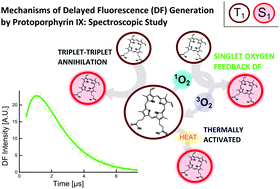Singlet oxygen feedback delayed fluorescence of protoporphyrin IX in organic solutions
Abstract
Delayed fluorescence (DF) of protoporphyrin IX (PpIX) has been recently proposed as a tool for monitoring of mitochondrial oxygen tension in vivo as well as for observation of the effectiveness of photodynamic therapy (PDT) [E. G. Mik, Anesth. Analg., 2013, 117, 834–346; F. Piffaretti et al., J. Biomed. Opt., 2012, 17, 115007]. However, the efficiency of the mechanism of thermal activation (E-type DF), which was considered in the papers, is limited due to a large energy gap between the first excited singlet and the first triplet state of PpIX at room or body temperatures. Moreover, the energy gap is roughly equal to other porphyrinoid photosensitizers that generate DF mostly through the Singlet Oxygen Feedback-Induced mechanism (SOFDF) under certain conditions [M. Scholz and R. Dědic, Singlet Oxygen: Applications in Biosciences and Nanosciences, 2016, vol. 2, pp. 63–81]. The mechanisms of delayed fluorescence of PpIX dissolved either in dimethylformamide (DMF) or in the mixture of DMF with ethylene glycol (EG) were investigated at atmospheric partial pressure of oxygen by means of a simultaneous time-resolved detection of 1O2 phosphorescence and PpIX DF which makes a direct comparison of the kinetics and lifetimes of both the luminescence channels possible. Samples of PpIX (100 μM) exhibit concave DF kinetics, which is a typical footprint of the SOFDF mechanism. The dramatic decrease in the DF intensity after adding a selective 1O2 quencher sodium azide (NaN3, 10 mM) proves that >90% of DF is indeed generated through SOFDF. Moreover, the analysis of the DF kinetics in the presence of NaN3 implies that the second significant mechanism of DF generation is the triplet–triplet annihilation (P-type DF). The bimolecular mechanism of DF was further confirmed by the decrease of the DF intensity in the more viscous mixture DMF/EG and by the increase of the ratio of DF to the prompt fluorescence (PF) intensity with the increasing excitation intensity. These results show the significant role of the SOFDF mechanism in the DF of PpIX at high concentrations and at atmospheric partial pressure of oxygen and should be considered when developing diagnostic tools for clinical applications.


 Please wait while we load your content...
Please wait while we load your content...